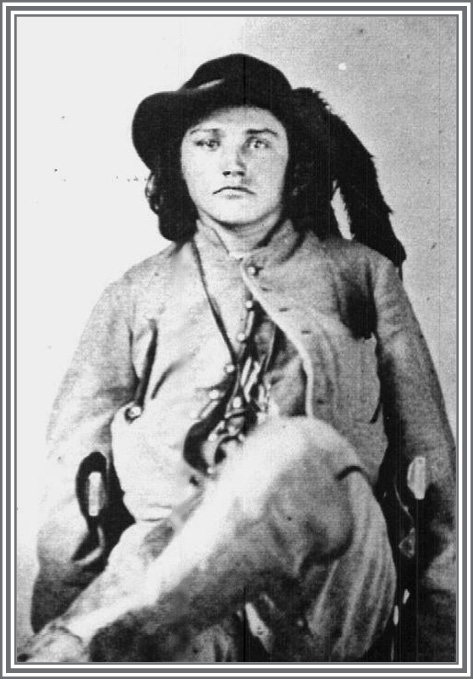Gabriel's Horses (12 page)
Authors: Alison Hart

During the Civil War, there were only a few battles fought in Kentucky. Horsemen in the Bluegrass region continued to breed, raise, and race horses. Wealthy horse owners from the South even brought their horses to Kentucky farms for safety.
Throughout the Civil War, however, Kentucky was plagued by Confederate raiders, often called “guerillas.” These men were on the side of the South. Some considered them heroes. Others considered them criminals. Frances Peter wrote in her diary that Rebels “broke open stores and robbed the merchants of boots, shoes and hats.” The guerrillas destroyed telegraph offices and supply lines and raided towns and farms, stealing whatever they needed. And what they really needed was horses.
Both the Confederate and Union armies needed horses. Horses and mules pulled supply wagons, cannon, and ambulances to and from the battlegrounds. They also carried cavalry soldiers and officers into battle. The Confederate guerrillas relied on them for raids, fights with Union soldiers, and quick getaways.
One of the most feared Confederate raiders was Sue Mundy, whose real name was Marcellus Jerome Clark. In October 1864, Mundy and his band of guerillas raided Woodburn Farm, one of the largest horse farms in the Lexington area. They stole five valuable horses, including Asteroid, a famous racehorse. The five animals were recovered, but in 1865 Mundy joined with another guerrilla leader, William Clarke Quantrill, and raided the farm again. This time they stole sixteen horses. Asteroid was saved by Ansel Williamson, the farm's trainer, who substituted a different horse. Six of the horses were never found again.

The notorious Confederate raider John Hunt Morgan rode and fought from Tennessee to Ohio. On July 9, 1864, General Morgan and his band battled a small Union force in Lexington. There, “his men seized hundreds of valuable thoroughbreds, more than enough to mount every rider on a fresh horse.” The following lines from the poem “Kentucky Belle,” written by Constance Fenimore Woolson (1840â1894), portray the fear evoked by this famous raider:
“I'm sent to warn the neighbors. He isn't a mile behind;
He sweeps up all the horsesâevery horse that he can find;
Morgan, Morgan the Raider and Morgan's terrible men,
With bowie knives and pistols, are galloping up the glen.”
Note:
The quote from Patsy Mitchner came from M
Y
F
OLKS
D
ON'T
W
ANT
M
E TO
T
ALK ABOUT
S
L
AVERY
: T
WENTY-ONE
O
RAL
H
ISTORIES OF
F
ORMER
N
ORTH
C
AROLINA
S
LAVES
by Belinda Hurmence (John F. Blair, NC: 1984). The quote from Silas Jackson came from I W
AS A
S
LAVE
: T
HE
L
IVES OF
S
LAVE
C
HILDREN
. The orders from Speed S. Fry and the quote about General Morgan came from C
AMP
N
ELSON
. The quote from Frances Peter came from A U
NION
W
OMAN
IN
C
IVIL
W
AR
K
ENTUCKY
. The verse from “Kentucky Belle” came from
www.civilwarpoetry.org
.
T
O
RESEARCH AND WRITE
G
ABRIEL'S
H
ORSES
, I read more than two hundred books. However, the following sources were crucial:
OOKS
:
- Clark, Thomas D.
A History of Kentucky
. J. Stuart Foundation: 1992. - Hollingsworth, Kent.
The Kentucky Thoroughbred.
The University Press of Kentucky: 1976. - Hotaling, Edward.
Great Black Jockeys.
Forum; Rockling, CA: 1999. - Howell, Donna Wyant, ed.
I Was a Slave: The Lives of Slave Children
(Book Five). American Legacy Books, Washington, DC: 1997. - Lucas, Marion B.
A History of Kentucky: From Slavery to Segregation, 1760â1891.
Kentucky Historical Society: 2003. - Mangum, William Preston. “Disaster at Woodburn Farm.” The Filson Club History Quarterly, April 1996, Vol. 70, No. 2, pp. 143â185.
- Mangum, William Preston.
My Kingdom for a Horse.
Harmony House Publishers, Louisville, KY: 1999. - Marrs, Elijah P.
Life and History of the Reverend Elijah P. Marrs.
Louisville, KY: 1885. - Peter, Frances.
A Union Woman in Civil War Kentucky: The Diary of Frances Peter.
University of Kentucky Press: 2000. - Renau, Lynn S.
Racing Around Kentucky.
Antiques Consultant Inc. Louisville, KY: 1995. - Sears, Richard D.
Camp Nelson, Kentucky.
The University Press of Kentucky: 2002.
EBSITES
:
T
HE FOLLOWING BOOKS
will help you learn more about slavery and life during the Civil War:
- Bial, Raymond.
The Strength of These Arms.
Houghton Mifflin Company, Boston: 1997. - Damon, Duane.
Growing up in the Civil War.
Lerner Publications, Minneapolis: 2003. - Diouf, Sylviane.
Growing up in Slavery.
The Millbrook Press, CN: 2001. - Greene, Meg.
Slave Young, Slave Long.
Lerner Publications Company, NY: 1999. - Hart, Alison.
Fires of Jubilee.
Aladdin Paperbacks, NY: 2003. - Hurmence, Belinda.
Slavery Time When I was Chillun.
GP Putnam's Sons, NY: 1997. - Kalman, Bobbie.
Life on a Plantation.
Crabtree Publishing Company, NY: 1997 - Kamma, Anne.
If You Lived When There Was Slavery in America.
Scholastic, Inc., NY: 2004. - Moore, Kay.
If You Lived at the Time of the Civil War.
Scholastic, Inc., NY: 1994.

ALISON HART
enjoys writing about history and horses, two of her favorite subjects. “I'd love to go back in time,” she says, “and meet people like Gabriel who followed their dreams, no matter what the hardships.” Researching G
ABRIEL'S
H
ORSES
took her to the Bluegrass region of Kentucky and its rich Thoroughbred racing and Civil War history. She soon realized that the suspenseful story of Gabriel and his family wouldn't fit in one book. The other titles in the Racing to Freedom trilogy will be G
ABRIEL'S
T
RIUMPH
and G
ABRIEL
's
J
OURNEY
.
Ms. Hart, a teacher and author, has written more than twenty books for children and young adults. Many of her titlesâincluding A
NNA'S
B
LIZZARD
, an
IRA
Teacher's Choice and
WILLA
Finalist, and S
HADOW
H
ORSE
, an Edgar Nomineeâfeature horses. Her historical mystery F
IRES OF
J
UBILEE
is also set at the time of the Civil War.

Published by
PEACHTREE PUBLISHERS
1700 Chattahoochee Avenue
Atlanta, Georgia 30318-2112
Text © 2007 by Alison Hart
All rights reserved. No part of this publication may be reproduced, stored in a retrieval system, or transmitted in any form or by any meansâelectronic, mechanical, photocopy, recording, or any otherâexcept for brief quotations in printed reviews, without the prior permission of the publisher.
Cover design by Loraine M. Joyner
Print book design by Melanie McMahon Ives
Photo credits:
Young slaves at work
,
Black trainer and jockey at the track
,
Isaac Murphy
,
Marcellus Jerome Clark
,
Union soldiers
, courtesy of the Library of Congress;
Barracks at Camp Nelson
, courtesy of the National Archives.
The Library of Congress has cataloged the print edition as follows:
Hart, Alison, 1950â
 Gabriel's horses / by Alison Hart. â 1st ed.
      p. cm.
 Summary: In Kentucky, during the Civil War, the twelve-year-old slave, Gabriel, deals with a new cruel horse trainer, skirmishes with Confederate Soldiers, and pursues his dream of becoming a jockey.
Â
ISBN
13: 978-1-56145-398-6 /
ISBN
10: 1-56145-398-6 (hardcover)
Â
ISBN
13: 978-1-56145-528-7 /
ISBN
10: 1-56145-528-8 (trade paperback)
[1. HorsesâFiction 2. Horse racingâFiction. 3. SlaveryâFiction. 4. African AmericansâFiction. 5. KentuckyâHistoryâCivil War, 1861â1865âFiction. 6. United StatesâHistoryâCivil War, 1861â1865âFiction.]Â Â I. Title.
 PZ7.H256272Gab 2007
 [Fic]âdc22
                                                           2006027697
